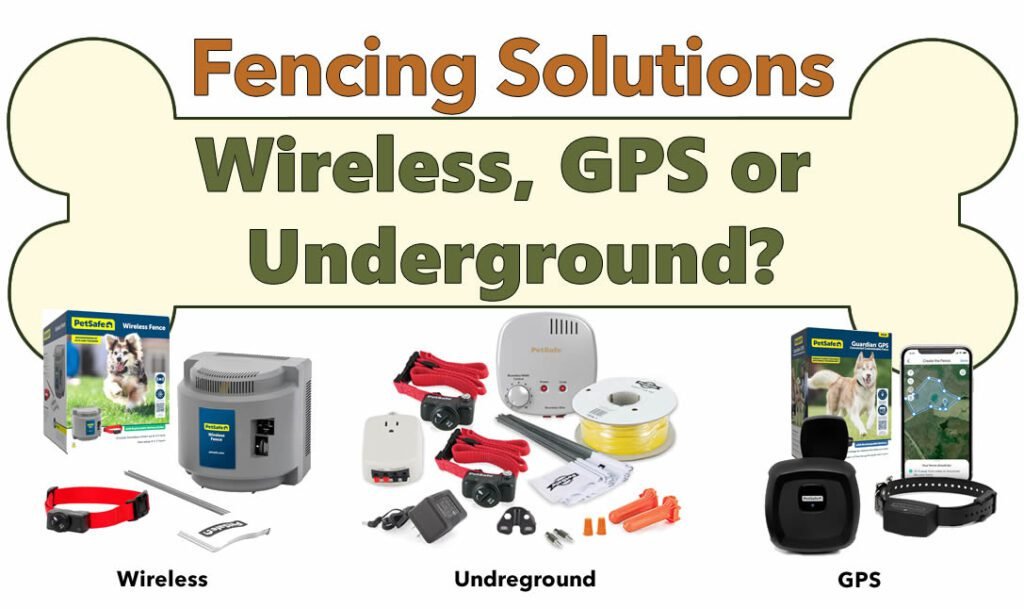

Intro
As a dog owner, keeping your furry friend safe is one of your top priorities. One way to ensure their safety is by using a dog fence. There are various types of dog fences available, and each offers unique advantages and disadvantages. Today, we will compare three of the most popular fencing options: wireless, GPS, and underground wire. By the end of this post, you will have a clearer idea about which of these might be the best solution for you and your canine companion.
Understanding the Wireless Dog Fence
Let’s dive right into the world of wireless dog fences. Imagine a virtual fence built around your yard, keeping your four-legged friend safe within a defined space. This is exactly what a wireless dog fence does. Operating with a central transmitter that communicates with a special collar your dog wears, the wireless fence establishes an invisible boundary for your pup. If your dog starts wandering too far, the collar sends out an alerting sound. If the boundary is still ignored, a harmless static correction will follow to guide your pet back. And the best part? This wireless system is super easy to set up and is highly portable, making it a go-to option for those who enjoy travel with their dogs.
Pros and Cons of the Wireless Dog Fence
Diving into the strengths and weaknesses of the wireless dog fence, it becomes apparent that its chief asset lies in its hassle-free installation. Kiss goodbye to hours spent digging or wrestling with wires; setting up this fence is as simple as flipping a switch. The adjustability of the boundary area is also a significant plus, catering to both small and large yards alike.
Perhaps the cherry on top is the portability feature of the wireless dog fence. Are you hitting the road for a family vacation or a weekend getaway? No worries! Pack up your wireless fence system and recreate a secure environment for your pup wherever your travels take you.
However, every rose has its thorns, and the wireless dog fence is no exception. One of the downsides of this system is its sensitivity to physical obstructions. Walls, large trees, or even thick shrubs can play havoc with the signal, potentially creating blind spots within the boundary area.
Additionally, the shape of the boundary area is usually circular due to the nature of the signal emitted by the central transmitter. This might pose a challenge if your yard has a unique shape or if you want to create a boundary that’s not round. It’s important to bear these factors in mind when considering a wireless fence for your four-legged friend.
Exploring the GPS Dog Fence
When it comes to cutting-edge technology for keeping your canine companion safely within the confines of your property, a GPS dog fence is certainly at the forefront. This system forges a virtual boundary using global positioning system technology. Here’s how it works: instead of focusing on the physical limitations of your yard, this fence uses GPS technology to keep tabs on your dog’s whereabouts. It’s like having a digital leash on your pooch!
As your furry friend approaches the virtual boundary that you’ve set, the collar will give an initial warning signal. This signal serves as a cue for your pet to step back from the boundary line. If your dog chooses to ignore this warning and continues to venture past the defined safe zone, a correction signal is then transmitted from the collar.
What makes this system truly stand out is its capacity to adapt to any yard shape. Whether you have a traditional square backyard, an irregularly shaped farm, or even a narrow stretch of land, the GPS dog fence is capable of accommodating it all. This flexibility is a significant advantage of the GPS system, allowing you to design a virtual boundary that mirrors the unique shape of your property.
However, it’s important to note that while this system offers significant advantages, it isn’t without its drawbacks. Relying heavily on satellite signals means the GPS dog fence can sometimes suffer from inconsistencies due to poor signal strength or other environmental factors. Also, the cost and maintenance of a GPS system can be a bit higher compared to other dog fencing options. Batteries for the collar may also need frequent replacements, which is another factor to consider. Nonetheless, for many dog owners, the benefits outweigh these potential downsides, making the GPS dog fence a favorite among tech-savvy pet parents.
Pros and Cons of the GPS Dog Fence
Delving deeper into the GPS dog fence’s details, it becomes clear that one of its key strengths is its high level of customization. Does your yard have a unique shape or a tricky layout? No problem! The GPS dog fence easily adjusts to any yard shape, offering you a flexible boundary that exactly matches your property’s layout. Plus, unlike wireless systems, this fence isn’t affected by physical obstructions, allowing for consistent coverage all around your yard.
However, with all the bells and whistles of the GPS system, a few drawbacks are bound to surface. One prominent hitch is its dependency on satellite signals. As robust as these signals usually are, they can occasionally be inconsistent due to environmental factors or poor signal strength, potentially affecting your fence’s reliability.
Another consideration is the cost. GPS dog fences generally carry a higher price tag compared to other options. This, coupled with a potential need for frequent battery replacements for the collar, might increase your overall expenses.
Despite these potential downsides, many tech-savvy pet parents continue to favor the GPS dog fence. For them, the unique benefits it offers, such as yard shape customization and uninterrupted signal coverage, make it an irresistible choice. As with any pet product, the best choice for you will depend on your specific needs, preferences, and circumstances. Remember, your ultimate goal is to create a safe and secure environment for your furry friend, and each fencing system we’ve explored can help you achieve that!
Unearthing the Underground Wire Dog Fence
The concept of an underground wire dog fence might sound a bit like a secret spy operation, but it’s actually a straightforward and reliable way to keep your canine companion within your yard’s boundaries. So, how does it work? Picture an invisible boundary drawn around your property. This boundary is established by a wire buried just beneath the surface of your ground, following the exact shape and size of your yard.
Here’s the genius behind it: this wire sends out a radio signal that communicates with a collar worn by your dog. If your pup begins to wander too close to the boundary, the collar gives a warning sound. If your dog continues to approach the boundary despite the warning, a mild static correction is then issued, prompting them to retreat.
While it might seem like an involved process, installing an underground wire dog fence can be a weekend DIY project for those handy with a shovel. While it may require more effort than setting up a wireless fence, many find the extra work well worth it for the increased reliability and precise boundary control this fencing option offers.
However, it’s worth noting that, like all things, underground wire fences aren’t indestructible. Over time, the wire can break due to environmental factors, like harsh weather conditions or even a pesky squirrel with a knack for digging. Should a break occur, it might be a bit of a detective hunt to locate the break for repair.
Despite the installation effort and potential for wire breaks, many pet parents find that the underground wire dog fence offers a winning combination of reliable performance and flexible yard boundary customization. Whether your yard is round, rectangular, or resembles a piece of abstract art, the underground wire fence can be adapted to fit it perfectly.
So, if you’re someone who appreciates a dependable system and doesn’t shy away from a little bit of hands-on installation work, unearthing the potential of an underground wire dog fence might just lead you to the perfect solution for your pet containment needs.
Pros and Cons of the Underground Wire Dog Fence
Delving into the world of underground wire dog fences, there are notable strengths and challenges to consider. One major advantage is the unparalleled flexibility it offers. Regardless of your yard’s shape or size, the underground wire fence can be custom-tailored to fit your property precisely. This fence, unlike its wireless counterpart, is not easily disrupted by physical obstacles, ensuring consistent coverage throughout your yard.
On the flip side, the installation process is notably more labor-intensive. As the name suggests, the fence wire needs to be buried beneath the surface of your yard. Although this can be a satisfying DIY project for the home handyman, it requires time and effort.
Additionally, Mother Nature and her smaller, furrier residents could pose a challenge. Over time, the wire may fall prey to harsh weather conditions or critters with a penchant for digging. If a break occurs, pinpointing the exact location for repair can feel a bit like a treasure hunt.
However, despite these potential challenges, many dog owners find the advantages of the underground wire dog fence compelling. For those who value a custom-fit boundary, reliability, and aren’t afraid of a little manual labor, this option might just hit the sweet spot. Remember, the perfect choice for you and your furry friend depends on your unique needs, preferences, and lifestyle.


